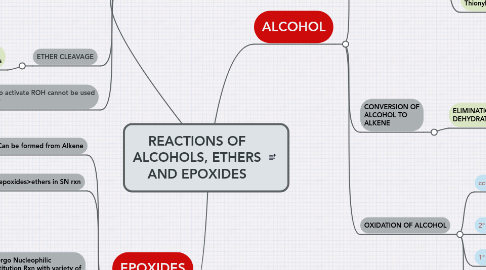
1. ETHER
1.1. OR group of Ether & OH group of alcohol: nearly same basicity
1.1.1. both conjugate acid have the same pKa
1.1.2. both are strong bases
1.1.2.1. poor leaving group
1.2. Activated before Nucleophilic Substitution
1.2.1. PROTONATION
1.3. Reaction with H-X
1.3.1. SLOW
1.3.2. HEAT IS REQUIRED
1.4. NUCLEOPHILIC SUBSTITUTION OF ETHER
1.4.1. SN1
1.4.1.1. 3° Carbocation
1.4.1.2. If the departure of ROH create a stable carbocations
1.4.2. SN2
1.4.2.1. a methyl, vinvyl, aryl or 1° carbocation
1.4.2.2. if the departure of leaving group create an unstable carbocation
1.4.2.2.1. leaving group cannot depart
1.4.2.2.2. need to be displaced by halide ion
1.5. ETHER CLEAVAGE
1.5.1. Forms only 1 substitution products
1.5.1.1. alkene that formed in the elimination reaction undergo electrophilic reaction with HBr/ HI
1.5.1.1.1. form Alkyl Halide
1.6. Reagents used to activate ROH cannot be used to activate ether
1.6.1. SOCl2, PCl3, TsCl
1.6.2. Oxygen atom does not have a proton that can dissociate
1.6.2.1. stable product cannot be formed
2. EPOXIDES
2.1. Can be formed from Alkene
2.1.1. By peroxyacid
2.1.2. Addition of HOCl followed by rxn with NaH
2.2. Reactivity: epoxides>ethers in SN rxn
2.2.1. the strain of the 3-membered ring is relieved when the ring opens
2.3. Undergo Nucleophilic Substitution Rxn with variety of NU
2.3.1. Acidic Conditions
2.3.1.1. Takes place readily at r.temp
2.3.1.2. Protonated Epoxides: Very Reactive
2.3.1.2.1. Can be opened by poor NU
2.3.1.3. If different substituents are attached to the two rings of the Protonated Epoxides
2.3.1.3.1. Major Product: with more substituted C
2.3.1.4. Partially SN1 & Partially SN2
2.3.1.4.1. Not pure SN1
2.3.1.4.2. Not pure SN2
2.3.2. Neutral or Basic Conditions
2.3.2.1. when the NU attack an unprotonated
2.4. Converting Alkene to Alcohol
2.4.1. Carbocation rearrangement can be avoided
2.4.2. By converting alkene to epoxides and treat the epoxides with NaH
2.4.2.1. Addition of acid protonate the alkoxide ion
2.4.2.2. Hydride ion is the NU that attacks the least substituted C of epoxides
3. ALCOHOL
3.1. CONVERSION OF ALCOHOL TO ALKYL HALIDES
3.1.1. NUCLEOPHILIC SUBSTITUTION REACTION
3.1.1.1. Has a STRONGLY BASIC LEAVING GP
3.1.1.1.1. PROTONATION OCCURS BEFORE SUBSTITUTION
3.1.1.2. SN1 reaction
3.1.1.2.1. Formed 2° and 3° R-X
3.1.1.2.2. more substitution product is formed
3.1.1.3. SN2 reaction
3.1.1.3.1. Formed 1° R-X
3.1.1.3.2. 1° carbocations are too unstable
3.1.1.4. When HCl is used
3.1.1.4.1. SN2 reaction will be slower
3.1.2. Phosphorus Trihalide (PCl3 or PBr3) or Thionyl Chloride (SOCl2)
3.1.2.1. convert R-OH to an intermediate with a leaving group that is readily displaced by halide
3.1.2.2. work well with 1° & 2° ROH
3.1.2.3. 3° ROH give poor yields
3.1.2.3.1. Intermediate formed is sterically hindered to back-side attack by halide ion
3.1.2.4. Pyridine
3.1.2.4.1. Acts as a solvent
3.1.2.4.2. poor NU
3.2. CONVERSION OF ALCOHOL TO ALKENE
3.2.1. ELIMINATION OF WATER MOLECULE: DEHYDRATION
3.2.1.1. E1 Dehydration
3.2.1.1.1. 2° & 3 Alcohol
3.2.1.2. E2 Dehydration
3.2.1.2.1. 1° Alcohol
3.3. OXIDATION OF ALCOHOL
3.3.1. commonly used reagent
3.3.1.1. Chromic Acid (H2CrO4)
3.3.1.2. Pyridine chlorochromate (PCC)
3.3.1.2.1. stops the reaction of 1° ROH at aldehyde
3.3.1.2.2. must used in anhydrous solvent
3.3.2. 2° Alcohol
3.3.2.1. Oxidized to Ketone
3.3.3. 1° Alcohol
3.3.3.1. Oxidized to Aldehyde
3.3.3.1.1. Further oxidized to Carbocylic Acid
3.3.3.2. Reaction stop at Aldehyde
3.3.3.2.1. using PCC
3.3.4. 3° Alcohol
3.3.4.1. DOES NOT UNDERGO OXIDATION
